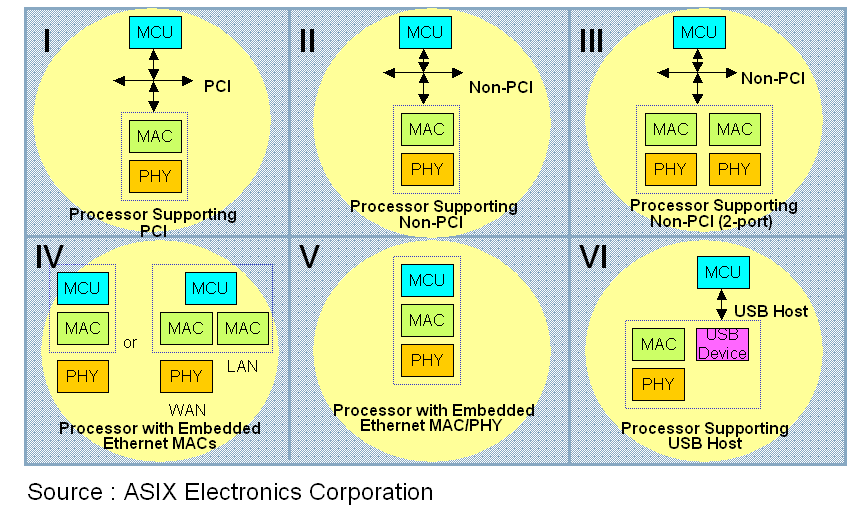There are six different embedded Ethernet solutions, as can be seen in the figure above. The first solution targets those devices with micro-controller embedded with PCI bus interface. The PCI bus Ethernet MAC+PHY controller is used to connect these devices to Ethernet. Nonetheless, there are only about 20% of the 32-bit micro-controllers that have an internal PCI bus, the majority of 8 or 16-bit micro-controllers do not use PCI bus for the cost reason. The micro-controllers normally use SRAM-like bus interface to extend the memory access and to inter-connect with the peripherals. In order to support PCI bus, the micro-controller will need extra more pins, which in turn adding more cost for the system. Also, the advanced PCI bus is designed mainly for the PC systems, and some of its features are indeed redundant for many embedded systems, such as plug-and-play.
The second solution targets devices with micro-controller, which comes without PCI bus interface, but with a non-PCI or SRAM type interface. In this case, the highly integrated Non-PCI bus Ethernet MAC+PHY controller is used to connect these devices to Ethernet. This solution provides the easiest way to connect the embedded system to the network for the reason that majority of the micro-controller all support Non-PCI local bus interface. The engineers are able to design very low cost, and yet high performance embedded systems, which offer remotes access capabilities in addition to Internet connectivity. This solution is suitable for home appliances, factory/building automation, industrial equipments, security systems, remote control/monitoring/management, streaming media, and multimedia networking. In addition, broadband applications such as POS terminals, WLAN AP, broadband router, VoIP, content distribution, IP STB, IP camera, digital video recorder, DVD recorder/player, high definition TV (HDTV), digital media adapter, game consoles, home gateway, and IPTV, etc., can also find this solution attractive and cost effective.
The third solution is targeted those devices which require two Ethernet connections simultaneously while being able to preserve existing processor hardware and software development investment. In this case, the highly integrated two-port Non-PCI bus Ethernet MAC+PHY controller is used to connect these devices to Ethernet through devices' internal layer 2 switching hardware. Normally in these devices, one port is used to connect to LAN while the other port is used to connect to WAN.
The fourth solution is for those devices with micro-controllers embedded either one or two port Ethernet MAC interfaces. With external Ethernet PHY controller, these devices can be easily connected to Ethernet.
The fifth solution is those micro-controllers, which already integrate both Ethernet MAC and PHY functions, the so-called single chip SoC solution. This solution makes the devices very compact, and is suitable for home appliances, factory/building automation, industrial equipments, security systems, remote control/monitoring/management, and streaming media applications such as POS terminals, vending machines, IP camera, Internet radio, automatic meter reading, environmental monitoring systems, network sensors, networked UPS, Serial to Ethernet adapter, and Ethernet to ZigBee bridge, can also find this solution quite attractive in cost, space, and power consumption-wise.
The sixth solution targets those micro-controllers that already have USB Host interface embedded. In this case, an internal or external USB-to-LAN controller can be used to connect these devices to Ethernet. This is exactly the USB-to-LAN solution described above for mobile devices. This solution is suitable for computer peripherals, handheld devices, home electronics and appliances, streaming media, broadband media, and other consumer electronics such as USB to Ethernet converter, USB WiMax adaptor, docking stations, cradles, and USB KVM Ethernet switches etc.
In summary, this white paper presents several ways of connecting mobile devices and the embedded systems to the network, particularly the Ethernet. As the need of network connectivity for the embedded systems are becoming more and more popular today, this will certainly change the dynamics of the whole embedded systems markets. This will also create a vast opportunity for the embedded systems and its providers for the future to come.
